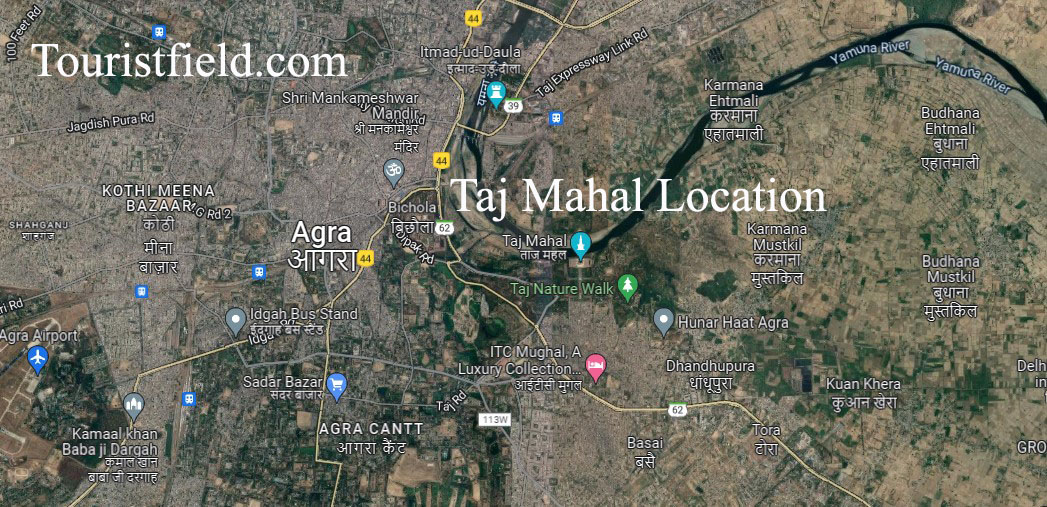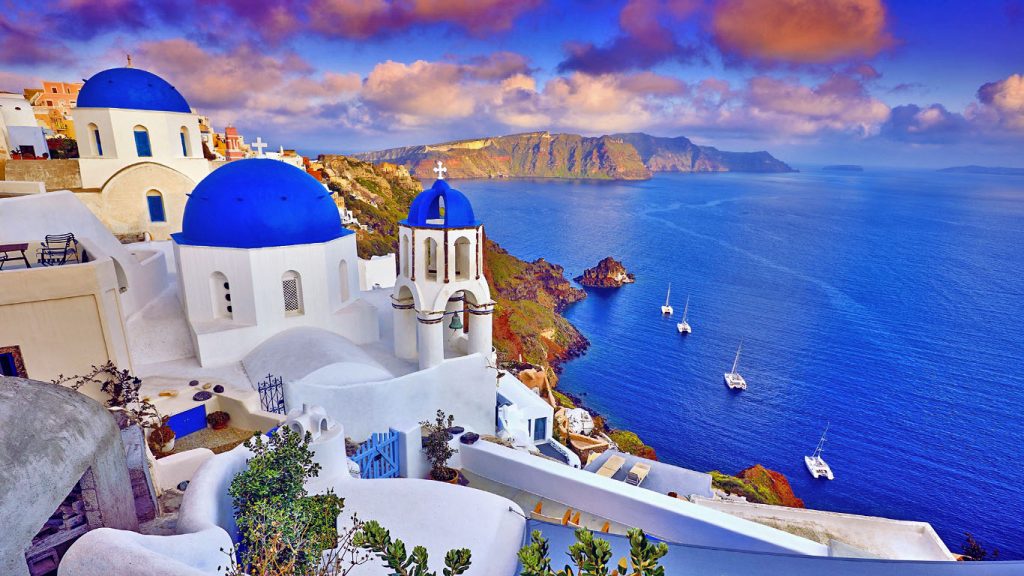Taj Mahal Locations Unveiled: A Journey Through Time and Beauty
Taj Mahal location at Dharmapuri, Forest Colony, Tajganj, Agra, Uttar Pradesh 282001, India. Agra, in the state of Uttar Pradesh, is about 213 kilometers (132.352 miles) from New Delhi. It is part of the popular Golden Triangle tourist circuit in India. The palace covers a total area of 17 hectares (170,000 m). Its construction was started in 1832. Construction was completed in 1653. The total height of the Taj Mahal is 63 meters. It is one of the types of Mughal architecture. The architectural style of the Taj Mahal was Mughal architecture. The main purpose of its construction was to give a gift to his wife and Shah Jahan built this building for his wife to keep his memories. It is made of marble. The Taj Mahal was built by Ustad Ahmad Lahori. More than 7000000 visitors visit the Taj Mahal every year.
To join Agra when coming from another country, one has to pass through New Delhi, which is more than 200 kilometers away from there. To get from one city to another you must take one of the two highways, which is expected to complete the journey in 3 hours. Don’t be surprised at the slowness of the distance, it takes much longer to cover the distance due to traffic in India.
Introduction
Welcome to the fascinating world of the Taj Mahal, where history, culture, and beauty come together. In this guide, we delve into the intricate details of the Taj Mahal location, offering insights and stories that bring this iconic landmark to life.
Location of Taj Mahal
The Taj Mahal, an architectural masterpiece, is located in the Indian city of Agra. Its location is more than just geographic coordinates; It is a testament to love and craftsmanship. Let’s embark on a journey to explore the location of the Taj Mahal and unravel the mystery surrounding this wonder.
Iconic Monument unveiled
The Taj Mahal, a symbol of enduring love and architectural brilliance, stands proudly in the heart of Agra, India. As we embark on this journey to uncover the location of the Taj Mahal, prepare to be mesmerized by the rich history, cultural significance, and breathtaking beauty that defines this iconic monument.
Tracing the roots of the Taj Mahal
To truly understand the Taj Mahal, we must trace its roots back to the 17th century. Commemorating Mughal Emperor Shah Jahan to his beloved wife Mumtaz Mahal, this mausoleum reflects the pinnacle of Mughal architecture. The Taj Mahal location, strategically located on the banks of the Yamuna River, adds a touch of serenity to the historical narrative.
A glimpse of Mughal splendor
The architectural wonder of the Taj Mahal is a testament to the glory of the Mughal Empire. LSI keywords grouped into sub-headings guide us through intricate designs, mesmerizing domes, and minarets adorning the structure. Every aspect of this masterpiece is a brushstroke on the canvas of Mughal splendor.
The mesmerizing ambiance of the location of the Taj Mahal
Beyond the ivory-white structure, the Taj Mahal has an enchanting geographical setting. Green gardens, serene paths, and the gentle flow of the Yamuna River form a picturesque backdrop. The Taj Mahal location is not merely a monument; It is a harmonious blend of nature and architecture.
Taj Mahal: Symbol of love and harmony
As we explore the Taj Mahal, we uncover its profound cultural impact. This iconic monument transcends religious and cultural boundaries, symbolizing eternal love and harmony. The Taj Mahal location serves as a universal symbol, attracting visitors from all walks of life to witness its beauty.
Behind the Scenes: Creating Timeless Structures
The construction of the Taj Mahal is as fascinating as the mystery of the monument itself. Skilled craftsmen and architects worked tirelessly to bring Shah Jahan’s vision to life. From the selection of pristine marble to the precision in detailing, every aspect of the Taj Mahal location tells a story of dedication and craftsmanship.
Explore complex details
Remarkable features such as intricate calligraphy, marble inlays, and the magical play of light make the Taj Mahal truly exceptional. The Taj Mahal location is a treasure trove of artistic details that captivate the eyes and soul of every visitor.
The Taj Mahal is steeped in magic
Visiting the Taj Mahal is a transformative experience. As soon as you step through the Grand Gateway, the beauty of the Taj Mahal unfolds in front of you. Sunrises and sunsets cast a magical glow on the marble surface, creating an ethereal atmosphere that is etched in your memory.
Preservation of heritage
Conservation efforts at the Taj Mahal are crucial to ensure its timeless beauty for future generations. The location of the Taj Mahal not only enshrines history but also demands our commitment to preserve its architectural magnificence.
Capturing beauty in every frame
Photographing the Taj Mahal requires more than just a camera; It requires an understanding of its essence. Our photography tips provide insight into framing the perfect shot, capturing the allure of the Taj Mahal with every click.
Folklore around the Taj Mahal
Local legends and myths add an extra layer of mystery to the Taj Mahal. From romantic tales of Shahjahan and Mumtaz Mahal to whispers of hidden chambers, these stories add to the mystical aura of the Taj Mahal’s location.
Influence on art, literature, and cinema
The influence of the Taj Mahal extends beyond its physical presence. Explore how this iconic monument has influenced art, literature, and cinema worldwide, becoming a cultural icon that resonates across media.
Historical significance
Immerse yourself in the rich history of the Taj Mahal. Located on the banks of the Yamuna River, it was commissioned by the Mughal Emperor Shah Jahan in memory of his beloved wife Mumtaz Mahal. The Taj Mahal’s location serves as a poignant reminder of eternal love, making it a pilgrimage site for lovers and history buffs alike. Embark on a historical journey as we uncover the origins of the Taj Mahal, a testament to enduring love and architectural brilliance.
To understand the roots of the Taj Mahal, we have to go back to the 17th century when the Mughal Emperor Shah Jahan commissioned this magnificent mausoleum. The Taj Mahal’s location, strategically chosen on the banks of the Yamuna River in Agra, India, adds a layer of poetic serenity to its historical narrative.
A love story carved in marble
The roots of the Taj Mahal are deeply intertwined with the love story of Shah Jahan and Mumtaz Mahal. Mumtaz, the emperor’s beloved wife, died tragically in childbirth. Grieving, Shah Jahan vowed to honor her memory with a structure that would surpass any other in beauty and grandeur.
Choosing the location of the Taj Mahal
The precise selection of the location of the Taj Mahal was not arbitrary. It reflects the emperor’s desire to create a heaven on earth for his beloved Mumtaz. The serene backdrop of the Yamuna River and the lush gardens surrounding the monument enhance its romantic atmosphere, demonstrating Shah Jahan’s commitment to creating a fitting tribute.
Architectural inspiration
Tracing the roots of the Taj Mahal leads us to various architectural inspirations. A fusion of Persian, Islamic, and Indian architectural styles is evident in its intricate designs, delicate carvings, and iconic domes. The Taj Mahal stands as a harmonious blend of cultural influences, showcasing the architectural prowess of the Mughal Empire.
Labor of Love: Construction Details
A huge workforce of skilled craftsmen and laborers was involved in the construction of the Taj Mahal. The use of white marble from Makrana in Rajasthan adds a timeless sheen to the monument. From the calligraphy adorning the walls to the intricate details of the gemstones, every aspect of its creation reflects dedication.
The location of the Taj Mahal today
As we trace the Taj Mahal’s roots, we witness its evolution into a global icon. The place, once a symbol of love for a grieving emperor, has been transformed into a UNESCO World Heritage Site that attracts millions of visitors annually. It stands not only as a monument to Mumtaz Mahal but also as a testament to India’s artistic and cultural heritage.
Eternal symbol of love
In tracing the roots of the Taj Mahal, one cannot ignore its enduring symbolism. The monument transcends time, representing the eternal love between Shah Jahan and Mumtaz Mahal. The location of the Taj Mahal, carefully chosen, becomes more than a physical space; It becomes a holy land where love lives.
In conclusion, tracing the roots of the Taj Mahal is a journey through the pages of history, love, and architectural genius. The Taj Mahal location, carefully selected and intricately designed, stands as living proof of a love story that has captured the hearts of generations. It invites visitors to witness not only a marvel of construction but a narrative carved into marble and time.
Architectural marvel
We enter the Mughal era as we explore the architectural splendor of the Taj Mahal. Adorned with intricate designs and studded with precious gems, the location exudes opulence. The minarets, central dome, and reflecting pool are masterpieces that showcase the genius of Mughal architecture.
A glimpse of Mughal splendor
Let’s step back in time and explore the opulent world of Mughal splendor encased in the architectural masterpiece, the Taj Mahal.
Architectural opulence
The Taj Mahal stands as a beacon of Mughal architectural brilliance. As we glimpse the Mughal splendor, we are greeted by the intricate designs, awe-inspiring domes, and towering minarets that define this iconic structure. LSI keywords subtly guide us through the magnificence that makes the Taj Mahal a jewel in the Mughal crown.
Mughal influence on design
Delving deep into the architecture of the Taj Mahal reveals the profound influence of the Mughal dynasty. A fusion of Persian, Islamic, and Indian styles results in a harmonious blend of geometric patterns, calligraphy, and floral motifs. Every aspect of the Taj Mahal reflects the exquisite taste and artistic vision of the Mughal architects.
Precious materials and craftsmanship
A glimpse of Mughal grandeur reveals the exquisite use of precious materials in the construction of the Taj Mahal. The choice of white marble from Makrana, inlaid with semi-precious stones, exemplifies the Mughal commitment to unparalleled craftsmanship. Intricate detailing, from fine carvings to marble lattice screens, is devoted to imperial perfection.
Symbolism in Design
The design of the Taj Mahal is not merely a display of architectural skill; It is meant with symbolism. The central dome symbolizes the eternal union of the emperor and empress, while the four minarets represent the four corners of the empire. In this context, Mughal became the language of art carrying stories of splendor, love, power, and eternity.
Gardens and water features
The Taj Mahal is not just an individual structure; It is complemented by a traditional Mughal garden Charbagh. The perfectly symmetrical layout, divided into four quadrants, is a testament to the Mughals’ love of order and balance. The reflecting pool, another feature of Mughal garden design, adds an ethereal quality, enhancing the overall grandeur.
Mughal legacy in architecture
Through the Taj Mahal, we see the Mughal splendor as we recognize its enduring influence on Indian architecture. Intricate arches, domes, and minarets are echoed in later Mughal structures and even beyond, leaving an indelible mark on the architectural landscape of the Indian subcontinent.
Every detail is artistically developed
Mughal grandeur lies not only in grandeur but also in the artistic flourishes evident in every detail. The delicate calligraphy, symmetrical arrangement, and play of light and shadow on the marble surface demonstrate the Mughal commitment to creating not just a building, but a masterpiece that stands the test of time.
In conclusion, a glimpse of Mughal splendor through the Taj Mahal is a journey through an era of artistic glory. The Taj Mahal, with its architectural opulence, intricate details, and deep symbolism, stands as a living testament to the glory of the Mughal dynasty. It invites visitors to not only witness history but immerse themselves in the splendor that defined an empire.
Geographical environment
Outside the ivory-white structure, the Taj Mahal has a picturesque setting. The location boasts gardens, charming paths, and a serene atmosphere. As the sun sets, the Yamuna River reflects the glow of the monument, creating a mesmerizing panorama.
Cultural influence
The Taj Mahal is more than just a structure; It symbolizes eternal love and cultural harmony. The location transcends religious and cultural boundaries, attracting visitors from around the world. Its influence on art, music, and literature is a testament to its cultural significance.
Construction secrets
Behind the magnificence lies the secret of the craftsmanship of Taj Mahal construction. Skilled craftsmen and architects worked tirelessly to create this masterpiece. From the choice of marble to the precision in detailing, every aspect contributes to the timeless allure of the Taj Mahal location.
Notable features
Every nook and cranny of the Taj Mahal tells a story. From the calligraphy on the walls to the intricate marble inlays, each feature is a wonder in itself. Explore the minarets, the central dome, and the beauty that makes the Taj Mahal a world-famous wonder.
Audience experience
Visiting the Taj Mahal is an experience like no other. The sight of the pristine marble structure takes your breath away as you enter the Grand Gateway. Witness the changing colors at sunrise and sunset and the serenity of the location will leave an indelible mark on your soul.
conservation efforts
Preserving the pristine beauty of the Taj Mahal is a collective responsibility. Learn about the ongoing conservation efforts that ensure this architectural gem stands the test of time. The location of the Taj Mahal not only echoes history but also demands our commitment to its preservation.
Photography Tips
Capturing the essence of the Taj Mahal requires more than just a camera. Discover insider tips to frame the perfect shot. Whether it’s the play of light on the marble or the reflection in the pool, these photography tips will help you immortalize your Taj Mahal experience.
Local legends and myths
The Taj Mahal is shrouded in local legends and myths. From romantic tales of Shahjahan and Mumtaz Mahal to whispers of hidden chambers, these stories add a layer of mystery to the location of the Taj Mahal. Explore the truth that separates myth and fiction.
The Taj Mahal in popular culture
Beyond its physical presence, the Taj Mahal has left an indelible mark on popular culture. It has inspired artists, writers, and filmmakers worldwide. Explore how the Taj Mahal’s stature permeates art, literature, and cinema, making it a global cultural icon.
Influence on art, literature, and cinema
Explore the Taj Mahal’s profound influence on various forms of artistic expression, literature, and cinematic masterpieces.
Artistic interpretation
The majestic beauty of the Taj Mahal has inspired countless artists around the world. From intricate paintings to detailed sketches, the influence of the Taj Mahal on art is undeniable. Artists try to capture the majesty of the monument, playing with color and perspective to convey the essence of Mughal grandeur. The Taj Mahal becomes a museum, inviting artists to translate its beauty into canvases that evoke wonder and admiration.
Literary reverie
In the realm of literature, the Taj Mahal often takes center stage as a symbol of love, devotion and architectural brilliance. Poets and writers weave stories around its white marble walls, bringing to life the love story of Shah Jahan and Mumtaz Mahal. The symbolism of the Taj Mahal transcends its physical presence, becoming a metaphor for eternal love and the passage of time. Literature, in turn, becomes a vessel for exploring the emotions and narratives inspired by this iconic monument.
Cinematic grandeur
Cinema, with its visual storytelling, has adopted the Taj Mahal as the backdrop for numerous films. The majesty of the Taj Mahal often serves as a cinematic metaphor, representing love, beauty and cultural richness. Be it a Bollywood romance or an international epic, filmmakers recognize the power of the Taj Mahal location to create visually stunning and emotionally resonant scenes. The monument’s timeless charm translates seamlessly to the silver screen.
Cultural symbols in music
Music, being a universal language has also touched the influence of the Taj Mahal. Composers drew inspiration from its elegance, incorporating motifs that reflected the monument’s grace. The influence of the Taj Mahal on musical composition ranges from classical pieces to modern interpretations that echo the Mughal era that retain the monument’s lasting legacy. Its presence in musical compositions adds another layer to the Taj Mahal’s diverse cultural influence.
Global architectural influence
Beyond India’s borders, the Taj Mahal has influenced architectural design worldwide. Buildings, bridges and monuments bear the hallmarks of the Taj Mahal. The use of white marble, intricate carvings, and symmetrical layouts reflect the global appreciation for Mughal architecture, with the Taj Mahal’s influence extending beyond the Indian subcontinent.
Capturing the essence
Photographers, both amateurs and professionals, try to capture the essence of the Taj Mahal through their lenses. Each photograph tries to convey the majesty of the monument, its changing colors in different lights, and the emotional depth it holds for the visitor. The influence of the Taj Mahal on photography extends beyond mere documentation; It becomes a pursuit to capture the intangible spirit that makes the monument timeless.
In conclusion, the Taj Mahal’s influence on art, literature, cinema, music, architecture, and photography is a testament to its universal appeal. As a cultural icon, it transcends geographical boundaries, leaving an indelible mark on the creative expression of artists, writers, filmmakers, musicians, and architects worldwide. The enduring legacy of the Taj Mahal inspires and shapes the cultural landscape across various artistic mediums.
Taj Mahal Location Distances:
Distance to the Taj Mahal from some parts of India:
- The distance from Agra city to the Taj Mahal is 5.3 kilometers. The Taj Mahal is located 5.3 kilometers from Agra. You can take a taxi. Taxis will take 12 to 15 minutes to cross this route.
- 658 km from Taj Mahal location Kushinagar International Airport, QVFW+7HC, Kushinagar – Ramkola Rd, Narainpur, Uttar Pradesh 274403, India
- 213 km from Delhi,
- 1956 km from Chennai,
- Located 1205 km from Mumbai,
- Located 1340 km from Kolkata,
Distance from other countries to the Taj Mahal:
For curiosity, know that the Taj Mahal / Taj Mahal Location for another country:
- 4047 kilometers from the Emerald Buddha Temple in Thailand,
- 6 748 kilometers from the Eiffel Tower in Bangkok,
- 3,792 km from the Forbidden City of Beijing,
- 6,895 km from the Tower of London,
- 11,959 km from the Statue of Liberty and
- 14,457 km from Rio Christ the Redeemer!
Frequently Asked Questions
- Question: Is the Taj Mahal location easily accessible?
Answer: Yes, the Taj Mahal is easily accessible in Agra city, well connected by road and rail. - Question: Are guided tours available at the Taj Mahal?
Answer: Absolutely! Guided tours are available, providing a deeper insight into the history and architecture of the Taj Mahal. - Question: What is the best time to visit the Taj Mahal?
Answer: The best time to visit is early morning or late afternoon to witness the changing colors of the monument. - Question: Can visitors enter the main tomb?
Answer: No, access to the main tomb is restricted to preserve the monument, but visitors can admire it from outside. - Question: Are there limitations in photography?
Answer: While photography is permitted in most areas, there are restrictions inside the main tomb for preservation purposes. - Question: Is the Taj Mahal open every day?
Answer: The Taj Mahal is open every day except Fridays, allowing visitors to explore its beauty throughout the week.
Conclusion
In conclusion, the enduring legacy of the Taj Mahal is not bound by time or boundaries. It lies in the love story it contains, the architectural brilliance it presents, and the cultural harmony it symbolizes. The location of the Taj Mahal, etched in our hearts, serves as a reminder that some legacies are not written in stone, but on the collective spirit of humanity.
A Timeless Legacy: The Taj Mahal’s Place in Our Hearts
Journey with us as we explore the enduring legacy of the Taj Mahal, a monument that transcends time, leaving an indelible mark on our hearts.
Embraced by eternal love
The Taj Mahal is more than a mere structure; It is a vessel that carries the weight of a timeless love story. In the heart of Agra, India, the Taj Mahal’s location serves as a physical testament to the undying love between Emperor Shah Jahan and Mumtaz Mahal. Their love story, engraved on the marble walls, resonates through the ages, making the Taj Mahal a symbol of eternal romance.
Awe-inspiring architecture
As we reflect on the enduring legacy of the Taj Mahal, its architectural grandeur stands out. The fine craftsmanship, intricate carvings, and elegant symmetry of the monument elevate it beyond a mere tomb. The Taj Mahal becomes a living proof of the architectural genius of the Mughal era, captivating the heart with its miraculous beauty.
A symbol of cultural harmony
The location of the Taj Mahal indicates more than its geographical coordinates; It represents a harmonious blend of cultures. In a country as diverse and culturally rich as India, the Taj Mahal stands as a beacon of unity. The combination of Persian, Islamic, and Indian styles of architecture exemplifies the beauty that emerges when different cultures come together. So the Taj Mahal resides not only in the heart of India but also in the collective heart of humanity.
Sunrise and sunset images
The enduring legacy of the Taj Mahal is perhaps most evident in the magical moments of sunrise and sunset. The changing hues of the marble, from soft pink to radiant gold, create a mesmerizing sight. As the sun kisses the Taj Mahal, the location transforms into a canvas of emotion, inviting visitors to witness the beauty that time cannot fade.
Conservation: Preserving History
Protecting the Taj Mahal is not a mere duty; It is a commitment to preserve history. Ongoing conservation efforts ensure that this architectural marvel continues to stand up to the ravages of time. The location of the Taj Mahal becomes a living heritage site, inviting generations to witness the past and carry forward its legacy.
Journey through local legends
Local legends and myths shroud the Taj Mahal in an air of mystery. From stories of hidden rooms to romantic whispers of Shahjahan and Mumtaz Mahal, these stories add depth to the legacy of the Taj Mahal. The location becomes a stage where folklore and reality dance together, weaving a narrative that captivates the imagination.
Personal Encounters: Audience Stories
The lasting legacy of the Taj Mahal extends beyond history books and documentaries. It lives in the personal encounters of the audience who stand in awe before its majesty. Each story, each shared moment, becomes a thread in the tapestry of the Taj Mahal’s legacy, connecting people from diverse backgrounds through a shared appreciation for beauty and history.
Beyond Borders: Global Appreciation
The Taj Mahal’s legacy is not limited to India’s borders; It extends globally. People from different parts of the world travel to witness its glory. The location of the Taj Mahal becomes a meeting place for people who, despite their differences, find common ground to marvel at this architectural marvel.



